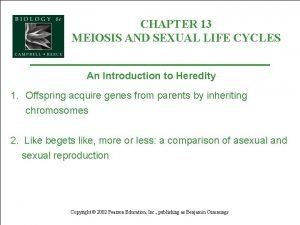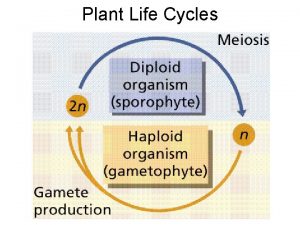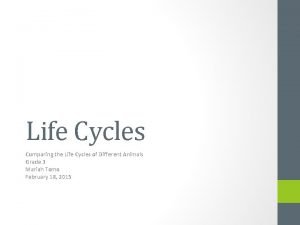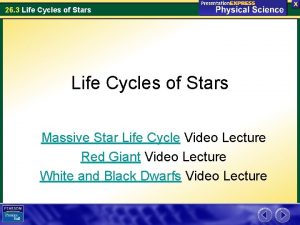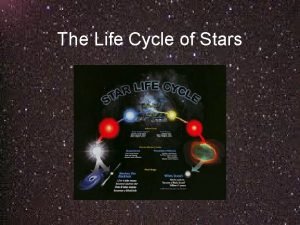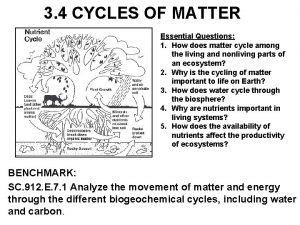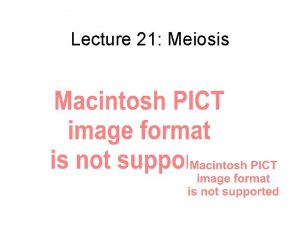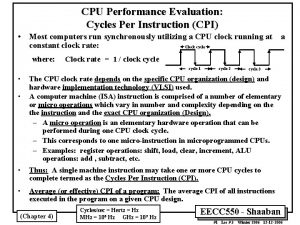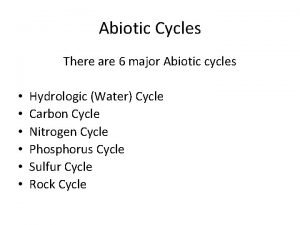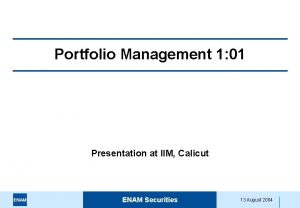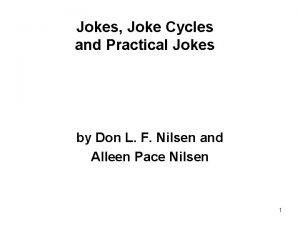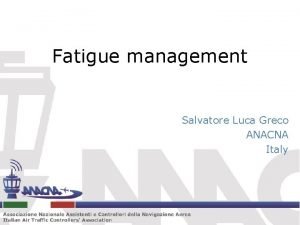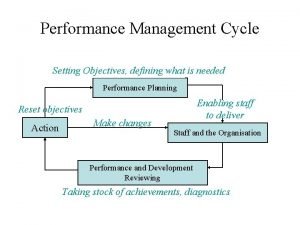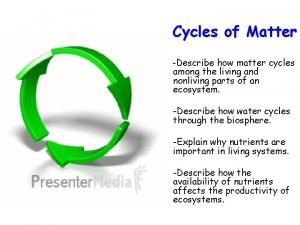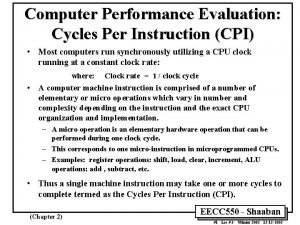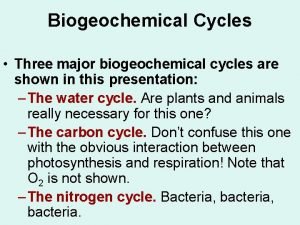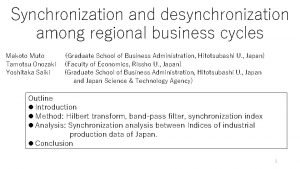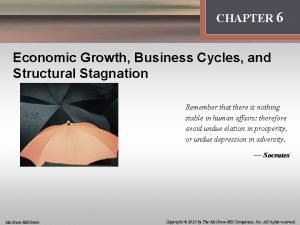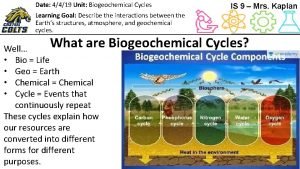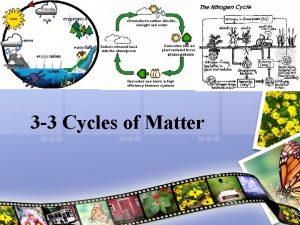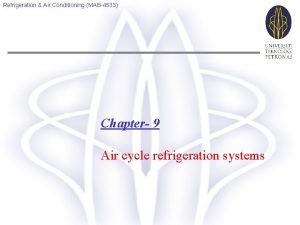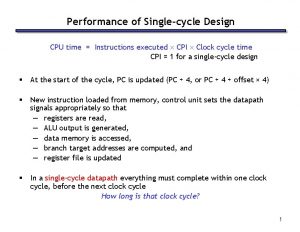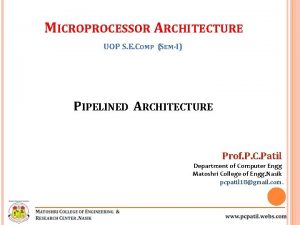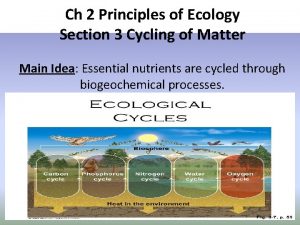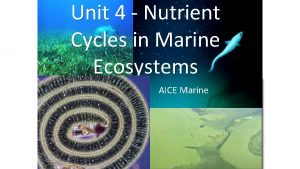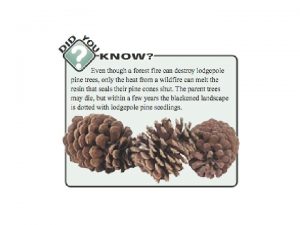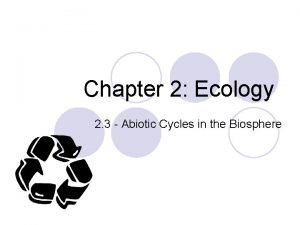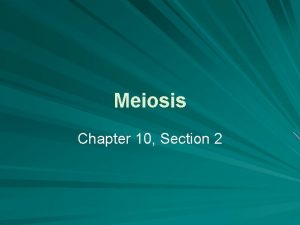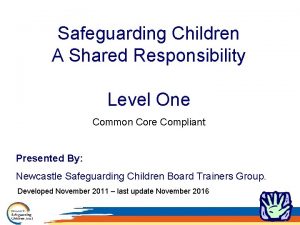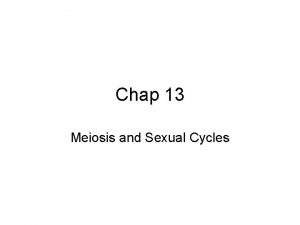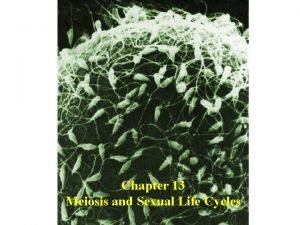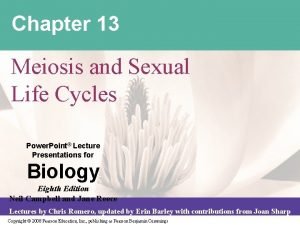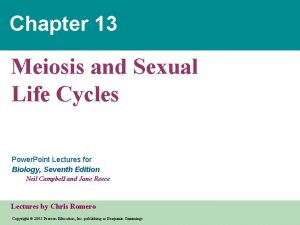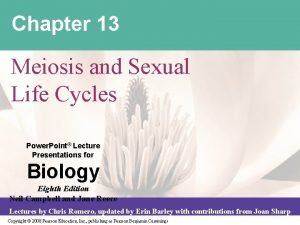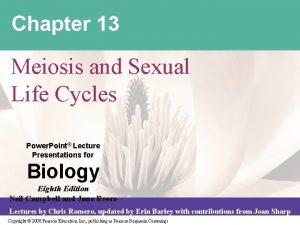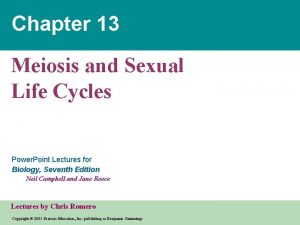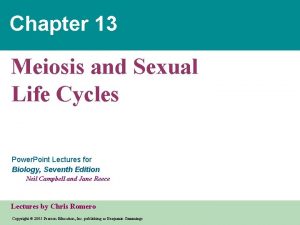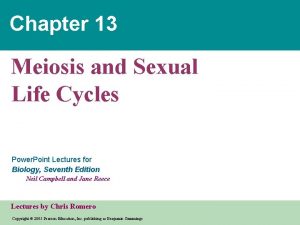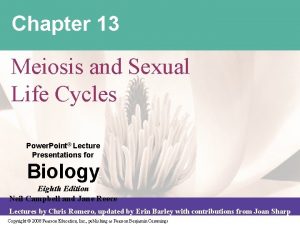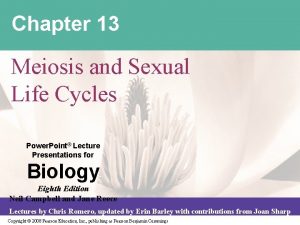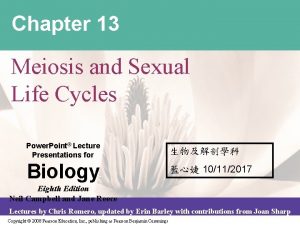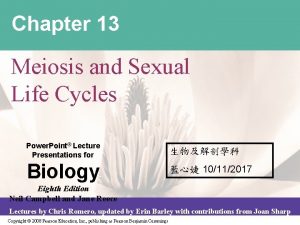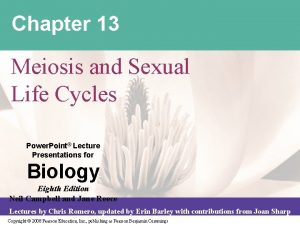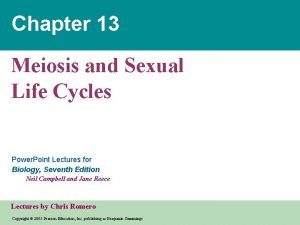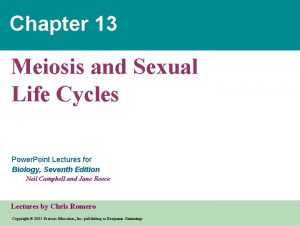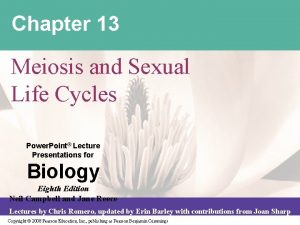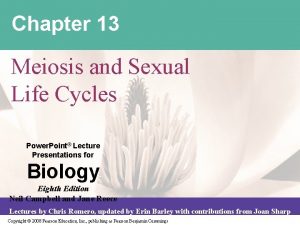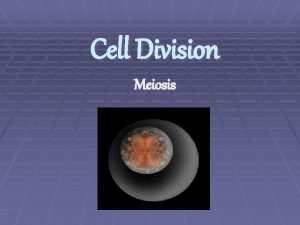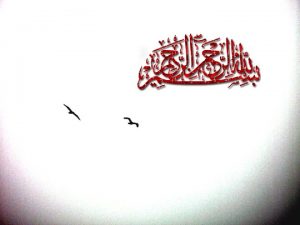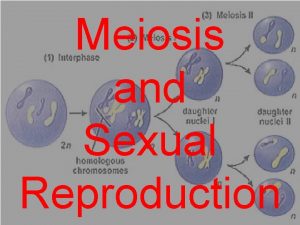Chapter 13 Meiosis and Sexual Life Cycles Power

























































































- Slides: 89

Chapter 13 Meiosis and Sexual Life Cycles Power. Point® Lecture Presentations for Biology Eighth Edition Neil Campbell and Jane Reece Lectures by Chris Romero, updated by Erin Barley with contributions from Joan Sharp Copyright © 2008 Pearson Education, Inc. , publishing as Pearson Benjamin Cummings

Overview: Variations on a Theme • Living organisms are distinguished by their ability to reproduce their own kind • Genetics is the scientific study of heredity and variation • Heredity is the transmission of traits from one generation to the next • Variation is demonstrated by the differences in appearance that offspring show from parents and siblings Copyright © 2008 Pearson Education Inc. , publishing as Pearson Benjamin Cummings

Fig. 13 -1

Concept 13. 1: Offspring acquire genes from parents by inheriting chromosomes • In a literal sense, children do not inherit particular physical traits from their parents • It is genes that are actually inherited Copyright © 2008 Pearson Education Inc. , publishing as Pearson Benjamin Cummings

Inheritance of Genes • Genes, the units of heredity, are found on chromosomes. • A gene’s specific location on a chromosome is called it’s locus • In sexual reproduction, two parents give rise to offspring that have unique combinations of genes inherited from the two parents Copyright © 2008 Pearson Education Inc. , publishing as Pearson Benjamin Cummings

Comparison of Asexual and Sexual Reproduction • One set of chromosomes are inherited from each parent, (specifically, each gamete). Therefore, a fertilized egg (a zygote) contains 2 sets of chromosomes. • A diploid cell (2 n) has 2 sets of chromosomes. Human somatic cells are diploids, and our number of chromosomes is ____. • The two sets are NOT clones! Copyright © 2008 Pearson Education Inc. , publishing as Pearson Benjamin Cummings

Fig. 13 -2 0. 5 mm Parent Bud (a) Hydra (b) Redwoods

Fig. 13 -2 a 0. 5 mm Parent Bud (a) Hydra

Fig. 13 -2 b (b) Redwoods

Concept 13. 2: Fertilization and meiosis alternate in sexual life cycles • A life cycle is the generation-to-generation sequence of stages in the reproductive history of an organism Copyright © 2008 Pearson Education Inc. , publishing as Pearson Benjamin Cummings

Sets of Chromosomes in Human Cells • The two chromosomes of each pair (maternal and paternal) are called homologous • Chromosomes in a homologous pair are the same length, as they carry the same number of very similar genes controlling the same inherited traits. Similar genes on a homologous pair are known as alleles. • A karyotype is an ordered display of these pairs of chromosomes from a single cell Copyright © 2008 Pearson Education Inc. , publishing as Pearson Benjamin Cummings

Fig. 13 -3 APPLICATION TECHNIQUE 5 µm Pair of homologous replicated chromosomes Centromere Sister chromatids Metaphase chromosome

Fig. 13 -3 a APPLICATION

Fig. 13 -3 b Karyotype: Pair of homologous chromosomes Sister chromatids 5 µm

• Human females have a homologous pair of sex chromosomes (XX) • Human males have one X and one Y chromosome, non-homologous • The 22 pairs of chromosomes that are not sex chromosomes are called autosomes Copyright © 2008 Pearson Education Inc. , publishing as Pearson Benjamin Cummings

• A gamete (sperm or egg) contains a single set of chromosomes, and is haploid (n) • For humans, the haploid number is 23. • Each set of 23 consists of 22 autosomes and a single sex chromosome • In an unfertilized egg (ovum), the sex chromosome is always X • In a sperm cell, the sex chromosome may be either X or Y Copyright © 2008 Pearson Education Inc. , publishing as Pearson Benjamin Cummings

Chromosomal number in somatic cells of various species: • Humans: 46 • Chimps: 48 • African Wild Dog: 78 • Fruit fly: 8 • Hedgehog: 90 • Broccoli: 18 • Yeast: 32 • Adder’s Tongue fern: 1200 (highest known of any species)

Fig. 13 -4 DIPLOID CELL Key 2 n = 6 Maternal set of chromosomes (n = 3) Paternal set of chromosomes (n = 3) Two sister chromatids of one replicated chromosome. These are identical. Centromere Pair of homologous chromosomes (one from each set) Will pair up only in meiosis

• At sexual maturity, the ovaries and testes produce haploid gametes • Fertilization and meiosis alternate in sexual life cycles to maintain chromosome number Copyright © 2008 Pearson Education Inc. , publishing as Pearson Benjamin Cummings

Fig. 13 -5 Key Haploid gametes (n = 23) Haploid (n) Egg (n) Diploid (2 n) Sperm (n) MEIOSIS Ovary FERTILIZATION Testis Diploid zygote (2 n = 46) Mitosis and development Multicellular diploid adults (2 n = 46)

Behavior of Chromosome Sets in the Human Life Cycle Copyright © 2008 Pearson Education Inc. , publishing as Pearson Benjamin Cummings

Copyright © 2008 Pearson Education Inc. , publishing as Pearson Benjamin Cummings

Copyright © 2008 Pearson Education Inc. , publishing as Pearson Benjamin Cummings

The Variety of Sexual Life Cycles • The alternation of meiosis and fertilization is common to all organisms that reproduce sexually • The three main types of sexual life cycles differ in the timing of meiosis and fertilization Copyright © 2008 Pearson Education Inc. , publishing as Pearson Benjamin Cummings

• In animals, meiosis produces gametes, which undergo no further cell division before fertilization • Gametes are the only haploid cells in animals • Gametes fuse to form a diploid zygote that divides by mitosis to develop into a multicellular organism Copyright © 2008 Pearson Education Inc. , publishing as Pearson Benjamin Cummings

Fig. 13 -6 Key Haploid (n) n Gametes n Mitosis n n MEIOSIS FERTILIZATION Diploid multicellular organism (a) Animals Zygote 2 n Mitosis n Spores Mitosis n n n MEIOSIS 2 n Haploid unicellular or multicellular organism Haploid multicellular organism (gametophyte) Diploid (2 n) Gametes Mitosis n n Gametes FERTILIZATION MEIOSIS 2 n Diploid multicellular organism (sporophyte) n 2 n Mitosis (b) Plants and some algae Zygote FERTILIZATION 2 n Zygote (c) Most fungi and some protists

Fig. 13 -6 a Key Haploid (n) Diploid (2 n) n Gametes n n MEIOSIS 2 n Diploid multicellular organism (a) Animals FERTILIZATION Zygote 2 n Mitosis

• Plants and some algae exhibit an alternation of generations • This life cycle includes both a diploid and haploid multicellular stage • The diploid organism, called the sporophyte, makes haploid spores by meiosis Copyright © 2008 Pearson Education Inc. , publishing as Pearson Benjamin Cummings

• Each spore grows by mitosis into a haploid organism called a gametophyte • A gametophyte makes haploid gametes by mitosis • Fertilization of gametes results in a diploid sporophyte Copyright © 2008 Pearson Education Inc. , publishing as Pearson Benjamin Cummings

Fig. 13 -6 b Key Haploid (n) Diploid (2 n) Mitosis n Haploid multicellular organism (gametophyte) Mitosis n n Spores MEIOSIS Gametes FERTILIZATION 2 n Diploid multicellular organism (sporophyte) 2 n Mitosis (b) Plants and some algae Zygote

• In most fungi and some protists, the only diploid stage is the single-celled zygote; there is no multicellular diploid stage • The zygote produces haploid cells by meiosis • Each haploid cell grows by mitosis into a haploid multicellular organism • The haploid adult produces gametes by mitosis Copyright © 2008 Pearson Education Inc. , publishing as Pearson Benjamin Cummings

Fig. 13 -6 c Key Haploid (n) Haploid unicellular or multicellular organism Diploid (2 n) Mitosis n n Gametes MEIOSIS n FERTILIZATION 2 n Zygote (c) Most fungi and some protists

• Depending on the type of life cycle, either haploid or diploid cells can divide by mitosis • However, only diploid cells can undergo meiosis • In all three life cycles, the halving and doubling of chromosomes contributes to genetic variation in offspring Copyright © 2008 Pearson Education Inc. , publishing as Pearson Benjamin Cummings

Concept 13. 3: Meiosis reduces the number of chromosome sets from diploid to haploid • Like mitosis, meiosis is preceded by the replication of chromosomes • Unlike mitosis, meiosis takes place in two sets of cell divisions • The two consecutive cell divisions, then, result in four daughter cells, rather than the two daughter cells in mitosis • The 4 cells each have half as many chromosomes as the parent cell, and each cell is unique, not a clone Copyright © 2008 Pearson Education Inc. , publishing as Pearson Benjamin Cummings

The Stages of Meiosis: REVIEW • The primary difference of meiosis from mitosis is that during meiosis: Homologous chromosomes join together briefly, exchange genes, and then randomly separate forever…. . like two ships that pass in the night. Copyright © 2008 Pearson Education Inc. , publishing as Pearson Benjamin Cummings

Fig. 13 -7 -3 Interphase Homologous pair of chromosomes in diploid parent cell Chromosomes replicate Diploid cell with replicated chromosomes Homologous chromosomes join here and exchange genes Homologous chromosomes separate Meiosis I 1 Haploid cells with replicated chromosomes Meiosis II 2 Haploid cells with unreplicated chromosomes Sister chromatids separate

Fig. 13 -7 -1 Interphase Homologous pair of chromosomes in diploid parent cell Chromosomes replicate Homologous pair of replicated chromosomes Sister chromatids Diploid cell with replicated chromosomes

Fig. 13 -7 -2 Interphase Homologous pair of chromosomes in diploid parent cell Chromosomes replicate Homologous pair of replicated chromosomes Sister chromatids Diploid cell with replicated chromosomes Meiosis I 1 Homologous chromosomes separate Haploid cells with replicated chromosomes

• Meiosis I is preceded by interphase, in which chromosomes are replicated to form sister chromatids • The sister chromatids are genetically identical and joined at the centromere • The single centrosome replicates, forming two centrosomes Bio. Flix: Meiosis Copyright © 2008 Pearson Education Inc. , publishing as Pearson Benjamin Cummings

Fig. 13 -8 Metaphase I Prophase I Centrosome (with centriole pair) Sister chromatids Chiasmata Spindle Centromere (with kinetochore) Prophase II Metaphase II Anaphase II Telophase II and Cytokinesis Sister chromatids remain attached Metaphase plate Homologous chromosomes separate Homologous chromosomes Fragments of nuclear envelope Telophase I and Cytokinesis Anaphase I Microtubule attached to kinetochore Cleavage furrow Sister chromatids separate Haploid daughter cells forming

• Division in meiosis I occurs in four phases: – Prophase I – Metaphase I – Anaphase I – Telophase I and cytokinesis Copyright © 2008 Pearson Education Inc. , publishing as Pearson Benjamin Cummings

Fig. 13 -8 a Prophase I Metaphase I Centrosome (with centriole pair) Sister chromatids Centromere (with kinetochore) Chiasmata Spindle Metaphase plate Sister chromatids remain attached Homologous chromosomes separate Homologous chromosomes Fragments of nuclear envelope Microtubule attached to kinetochore Telophase I and Cytokinesis Anaphase I Cleavage furrow

Prophase I • Prophase I typically occupies more than 90% of the time required for meiosis The lovers meet… Copyright © 2008 Pearson Education Inc. , publishing as Pearson Benjamin Cummings

In Prophase I, synapsis occurs. Synapsis (also called a “chiasma”) is the process where homologous chromosomes form a TETRAD. During synapsis, chromosomes (in tetrad formation) undergo crossing over, where paired homologous chromosomes exchange specific alleles. The lovers entwine… Copyright © 2008 Pearson Education Inc. , publishing as Pearson Benjamin Cummings

Metaphase I • In metaphase I, all tetrads line up at the metaphase plate, with one homologous chromosome from each pair facing opposite poles, kinetichore microtubules attached. Pairs of lovers gather… Copyright © 2008 Pearson Education Inc. , publishing as Pearson Benjamin Cummings

Fig. 13 -8 b Prophase I Sister chromatids Metaphase I Crossing over Tetrad Microtubule attached to kinetochore attached to centromere

Anaphase I • In anaphase I, homologous chromosomes separate from their tetrad, and move randomly to either end of the cell. This is called independent assortment. It is 50/50 whether a chromosome will wind up at one pole or the other. (However, chromatids remain attached at the centromere and move as one unit toward the pole) The lovers say goodbye… Copyright © 2008 Pearson Education Inc. , publishing as Pearson Benjamin Cummings

Telophase I and Cytokinesis • In the beginning of telophase I, each half of the cell has a haploid set of chromosomes; each chromosome still consists of two sister chromatids • Cytokinesis usually occurs simultaneously, forming two haploid daughter cells Copyright © 2008 Pearson Education Inc. , publishing as Pearson Benjamin Cummings

• NOTE: No chromosome replication occurs between the end of meiosis I and the beginning of meiosis II because the chromosomes are already replicated Copyright © 2008 Pearson Education Inc. , publishing as Pearson Benjamin Cummings

Fig. 13 -8 c Telophase I and Cytokinesis Anaphase I Sister chromatids remain attached Homologous chromosomes separate Cleavage furrow

• Meiosis II is basically mitosis Copyright © 2008 Pearson Education Inc. , publishing as Pearson Benjamin Cummings

Prophase II Copyright © 2008 Pearson Education Inc. , publishing as Pearson Benjamin Cummings

Metaphase II • In metaphase II, the chromosomes, with sister chromatids, are arranged at the metaphase plate • Remember, due to crossing over in meiosis I, the two sister chromatids of each chromosome are no longer genetically identical Copyright © 2008 Pearson Education Inc. , publishing as Pearson Benjamin Cummings

Fig. 13 -8 e Prophase II Metaphase II

Anaphase II • In anaphase II, the sister chromatids separate • The sister chromatids of each chromosome now move as two newly individual chromosomes toward opposite poles Copyright © 2008 Pearson Education Inc. , publishing as Pearson Benjamin Cummings

Telophase II and Cytokinesis • In telophase II, the chromosomes arrive at opposite poles • Nuclei form, and the chromosomes begin decondensing Copyright © 2008 Pearson Education Inc. , publishing as Pearson Benjamin Cummings

• At the end of meiosis, there are four daughter cells, each with a haploid set of chromosomes • Each daughter cell is genetically distinct from the others and from the parent cell • In spermatogenesis, the four cells grow tails. In oogenesis, one of the four cells gets all the cytoplasm and becomes the egg. The other three become “polar bodies”. Copyright © 2008 Pearson Education Inc. , publishing as Pearson Benjamin Cummings

Fig. 13 -8 f Anaphase II Telephase II and Cytokinesis Sister chromatids separate Haploid daughter cells forming

Fig. 13 -8 d Prophase II Metaphase II Anaphase II Telophase II and Cytokinesis Sister chromatids separate Haploid daughter cells forming

A Comparison of Mitosis and Meiosis • Mitosis conserves the number of chromosome sets, producing cells that are genetically identical to the parent cell. Foundation of asexual reproduction. • Meiosis reduces the number of chromosomes sets from two (diploid) to one (haploid), producing cells that differ genetically from each other and from the parent cell. Foundation of sexual reproduction. Copyright © 2008 Pearson Education Inc. , publishing as Pearson Benjamin Cummings

Fig. 13 -9 a MITOSIS MEIOSIS Parent cell Chromosome replication Prophase Crossing Over Chromosome replication Prophase I Homologous chromosome pair 2 n = 6 Replicated chromosome MEIOSIS I Metaphase I Anaphase Telophase Anaphase I Telophase I Haploid n=3 Daughter cells of meiosis I 2 n Daughter cells of mitosis 2 n MEIOSIS II n n Daughter cells of meiosis II

Fig. 13 -9 b SUMMARY Property Mitosis Meiosis DNA replication Occurs during interphase before mitosis begins Occurs during interphase before meiosis I begins Number of divisions One, including prophase, metaphase, and telophase Two, each including prophase, metaphase, and telophase Synapsis of homologous chromosomes Does not occur Occurs during prophase I along with crossing over between nonsister chromatids; resulting chiasmata hold pairs together due to sister chromatid cohesion Number of daughter cells and genetic composition Two, each diploid (2 n) and genetically identical to the parent cell Four, each haploid (n), containing half as many chromosomes as the parent cell; genetically different from the parent cell and from each other Role in the animal body Enables multicellular adult to arise from zygote; produces cells for growth, repair, and, in some species, asexual reproduction Produces gametes; reduces number of chromosomes by half and introduces genetic variability among the gametes

Fig. 13 -9 MITOSIS MEIOSIS Parent cell Chromosome replication Prophase Chiasma Chromosome replication Prophase I Homologous chromosome pair 2 n = 6 Replicated chromosome MEIOSIS I Metaphase I Anaphase Telophase Anaphase I Telophase I Haploid n=3 Daughter cells of meiosis I 2 n MEIOSIS II 2 n Daughter cells of mitosis n n Daughter cells of meiosis II SUMMARY Property Mitosis Meiosis DNA replication Occurs during interphase before mitosis begins Occurs during interphase before meiosis I begins Number of divisions One, including prophase, metaphase, anahase, and telophase Two, each including prophase, metaphase, and telophase Synapsis of homologous chromosomes Does not occur Occurs during prophase I along with crossing over between nonsister chromatids; resulting chiasmata hold pairs together due to sister chromatid cohesion Number of daughter cells and genetic composition Two, each diploid (2 n) and genetically identical to the parent cell Four, each haploid (n), containing half as many chromosomes as the parent cell; genetically different from the parent cell and from each other Role in the animal body Enables multicellular adult to arise from zygote; produces cells for growth, repair, and, in some species, asexual reproduction Produces gametes; reduces number of chromosomes by half and introduces genetic variability amoung the gametes

• Three events are unique to meiosis, and all three occur in meiosis l: – Synapsis and crossing over in prophase I: Homologous chromosomes physically connect and exchange genetic information – At the metaphase plate, there are paired homologous chromosomes (tetrads), instead of individual replicated chromosomes – At anaphase I, it is homologous chromosomes, instead of sister chromatids, that separate Copyright © 2008 Pearson Education Inc. , publishing as Pearson Benjamin Cummings

• Sister chromatid cohesion allows sister chromatids of a single chromosome to stay together through meiosis I • Protein complexes called cohesins are responsible for this cohesion • In mitosis, cohesins are cleaved at the end of metaphase • In meiosis, cohesins are cleaved along the chromosome arms in anaphase I (separation of homologs) and at the centromeres in anaphase II (separation of sister chromatids) Copyright © 2008 Pearson Education Inc. , publishing as Pearson Benjamin Cummings

Fig. 13 -10 EXPERIMENT Shugoshin – Shugoshin + (normal)+ Spore case Fluorescent label Metaphase I Anaphase I Metaphase II OR Anaphase II Mature spores Spore cases (%) RESULTS 100 80 60 40 20 0 Shugoshin+ Shugoshin– ? ? Two of three possible arrangements of labeled chromosomes

Fig. 13 -10 a EXPERIMENT Shugoshin+ (normal) Fluorescent label Spore case Shugoshin– Metaphase I Anaphase I Metaphase II OR Anaphase II Mature spores Spore ? ? Two of three possible arrangements of labeled chromosomes

Fig. 13 -10 b Spore cases (%) RESULTS 100 80 60 40 20 0 Shugoshin+ Shugoshin–

Concept 13. 4: Genetic variation produced in sexual life cycles contributes to evolution • Mutation (incorrect or missing nucleotides, accidental copying or deletion of genes) is a key source of genetic diversity. Mutations are very rarely beneficial to a species, but when they are, they tend to stick around. Mutations may create different versions of genes called alleles. • (ex: blue eyes from brown eyes) • But variation also exists HERE Copyright © 2008 Pearson Education Inc. , publishing as Pearson Benjamin Cummings

Origins of Genetic Variation Among Offspring • Independent assortment • Crossing over • Random fertilization Copyright © 2008 Pearson Education Inc. , publishing as Pearson Benjamin Cummings

Independent Assortment of Chromosomes • The number of combinations possible when chromosomes assort independently into gametes is 2 n, where n is the haploid number • Each chromosome has a 50% chance of moving to one pole of the cell or the other. • For humans (n = 23), there are more than 8 million (223) possible combinations of chromosomes. Copyright © 2008 Pearson Education Inc. , publishing as Pearson Benjamin Cummings

Crossing Over • Crossing over produces recombinant chromosomes, which combine genes inherited from each parent • The total possible combinations of genes crossing over on even a single pair of homologs with, say 1000 genes each, are…very large indeed. Copyright © 2008 Pearson Education Inc. , publishing as Pearson Benjamin Cummings

Random Fertilization • Finally, random fertilization adds to genetic variation because any sperm (1 of the 300 million in a common ejaculate) may fuse with any ovum (1 of 300, 000) during one mating • Therefore fusion of two specific gametes produces a human zygote with any of about 70 trillion diploid combinations. Copyright © 2008 Pearson Education Inc. , publishing as Pearson Benjamin Cummings

• Therefore, each zygote has a unique genetic identity. You are one in 70 trillion! Animation: Genetic Variation Copyright © 2008 Pearson Education Inc. , publishing as Pearson Benjamin Cummings

Copyright © 2008 Pearson Education Inc. , publishing as Pearson Benjamin Cummings

The Evolutionary Significance of Genetic Variation Within Populations • Natural selection results in the accumulation of genetic variations favored by the environment • Sexual reproduction contributes to the genetic variation in a population, which originates from mutations Copyright © 2008 Pearson Education Inc. , publishing as Pearson Benjamin Cummings

Fig. 13 -11 -1 Possibility 2 Possibility 1 Two equally probable arrangements of chromosomes at metaphase I

Fig. 13 -11 -2 Possibility 1 Two equally probable arrangements of chromosomes at metaphase I Metaphase II

Fig. 13 -11 -3 Possibility 2 Possibility 1 Two equally probable arrangements of chromosomes at metaphase I Metaphase II Daughter cells Combination 1 Combination 2 Combination 3 Combination 4

Fig. 13 -12 -1 Prophase I of meiosis Pair of homologs Nonsister chromatids held together during synapsis

Fig. 13 -12 -2 Prophase I of meiosis Pair of homologs Chiasma Centromere TEM Nonsister chromatids held together during synapsis

Fig. 13 -12 -3 Prophase I of meiosis Pair of homologs Chiasma Centromere TEM Anaphase I Nonsister chromatids held together during synapsis

Fig. 13 -12 -4 Prophase I of meiosis Pair of homologs Chiasma Centromere TEM Anaphase II Nonsister chromatids held together during synapsis

Fig. 13 -12 -5 Prophase I of meiosis Pair of homologs Nonsister chromatids held together during synapsis Chiasma Centromere TEM Anaphase II Daughter cells Recombinant chromosomes

Fig. 13 -UN 1 Prophase I: Each homologous pair undergoes synapsis and crossing over between nonsister chromatids. Metaphase I: Chromosomes line up as homologous pairs on the metaphase plate. Anaphase I: Homologs separate from each other; sister chromatids remain joined at the centromere.

Fig. 13 -UN 2 F H

Fig. 13 -UN 3

Fig. 13 -UN 4

You should now be able to: 1. Distinguish between the following terms: somatic cell and gamete; autosome and sex chromosomes; haploid and diploid 2. Describe the events that characterize each phase of meiosis 3. Describe three events that occur during meiosis I but not mitosis 4. Name and explain the three events that contribute to genetic variation in sexually reproducing organisms Copyright © 2008 Pearson Education Inc. , publishing as Pearson Benjamin Cummings
 Chapter 13 meiosis and sexual life cycles
Chapter 13 meiosis and sexual life cycles Chapter 13 meiosis and sexual life cycles
Chapter 13 meiosis and sexual life cycles Meiosis and genetic variation usatestprep
Meiosis and genetic variation usatestprep Study guide chapter 10 section 1 meiosis
Study guide chapter 10 section 1 meiosis Chapter 10 section 1 meiosis
Chapter 10 section 1 meiosis Section 1 meiosis
Section 1 meiosis Chapter 10 section 3 gene linkage and polyploidy
Chapter 10 section 3 gene linkage and polyploidy Differences between mitosis and meiosis
Differences between mitosis and meiosis Fadlife
Fadlife Plant life cycles and alternation of generations
Plant life cycles and alternation of generations Vapour power cycles
Vapour power cycles 11/15
11/15 Meiosis 1
Meiosis 1 Oogensis
Oogensis Alliteration words for cycle
Alliteration words for cycle Bill nye the science guy life cycles
Bill nye the science guy life cycles Life cycles of a bird
Life cycles of a bird Section 26.3 life cycles of stars
Section 26.3 life cycles of stars What is charted on an hr diagram
What is charted on an hr diagram Xenospores
Xenospores Precipitation in the water cycle
Precipitation in the water cycle Draw power triangle
Draw power triangle Compare and contrast carbon and nitrogen cycles
Compare and contrast carbon and nitrogen cycles Chapter 10 sexual reproduction and genetics
Chapter 10 sexual reproduction and genetics Chapter 10 sexual reproduction and genetics
Chapter 10 sexual reproduction and genetics Stockspotter
Stockspotter Interphase of meiosis
Interphase of meiosis Chapter 20 sexual reproduction in animals
Chapter 20 sexual reproduction in animals Mandarin cycles
Mandarin cycles Importance of water cycle
Importance of water cycle Pdsa cycles
Pdsa cycles Precession milankovitch cycles
Precession milankovitch cycles Relationship between transaction cycles
Relationship between transaction cycles Cpi cycles per instruction
Cpi cycles per instruction Biogeochemical cycles performance task
Biogeochemical cycles performance task Apes cycles
Apes cycles The major abiotic reservoir for phosphorus is
The major abiotic reservoir for phosphorus is Biogeochemical cycles quiz
Biogeochemical cycles quiz Enam securities portfolio
Enam securities portfolio Joke cycles
Joke cycles Joke cycles
Joke cycles Biogeochemical cycles class 9 ppt
Biogeochemical cycles class 9 ppt Sleep wake cycles
Sleep wake cycles Cell cycle foldable project
Cell cycle foldable project Design science research cycles
Design science research cycles Biogeochemical cycles poster
Biogeochemical cycles poster Siklus pdsa
Siklus pdsa Alphonse mucha advertising
Alphonse mucha advertising Stages of the performance management cycle
Stages of the performance management cycle Water cycles of matter
Water cycles of matter Isagenix cycles chart
Isagenix cycles chart Multiplication of cycles
Multiplication of cycles Cycles per instruction
Cycles per instruction Tidal patterns
Tidal patterns 4 major biogeochemical cycles
4 major biogeochemical cycles Carbon cycle pearson education
Carbon cycle pearson education Mandarin cycles
Mandarin cycles Cycle
Cycle Business cycles economics
Business cycles economics Per capita real gdp formula
Per capita real gdp formula Milankovitch cycles
Milankovitch cycles End-to-end procurement life cycle
End-to-end procurement life cycle Biogeochemical cycles
Biogeochemical cycles Generalization in database
Generalization in database Milankovitch cycles
Milankovitch cycles Milankovitch cycle
Milankovitch cycle 3-3 cycles of matter
3-3 cycles of matter Minerals vs elements
Minerals vs elements Refrigeration and air conditioning cycle
Refrigeration and air conditioning cycle Cpi cycles per instruction
Cpi cycles per instruction Mineral cycle diagram
Mineral cycle diagram ……………types of bus cycles / operations in 80386dx
……………types of bus cycles / operations in 80386dx Arduino uno logo
Arduino uno logo Lesson 2 cycles of matter answer key
Lesson 2 cycles of matter answer key Rock cylce
Rock cylce Solid rock cycles
Solid rock cycles Nutrient cycles in marine ecosystems
Nutrient cycles in marine ecosystems Business cycles occur in free enterprise systems because
Business cycles occur in free enterprise systems because Kondratieff cycles geography
Kondratieff cycles geography Practice geochemical cycles answer key
Practice geochemical cycles answer key Abiotic cycles
Abiotic cycles Solar power satellites and microwave power transmission
Solar power satellites and microwave power transmission Actual power and potential power
Actual power and potential power Mobile ka
Mobile ka Chapter 10 section 1 meiosis answers
Chapter 10 section 1 meiosis answers Sexual abuse signs and symptoms
Sexual abuse signs and symptoms Victoria climbe
Victoria climbe Venn diagram of asexual and sexual
Venn diagram of asexual and sexual Binary fission in bacteria
Binary fission in bacteria Mitosis vs meiosis
Mitosis vs meiosis

